|
|
|
Sort Order |
|
|
|
Items / Page
|
|
|
|
|
|
|
| Srl | Item |
| 1 |
ID:
101927
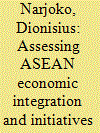

|
|
|
| 2 |
ID:
091978
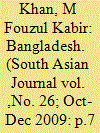

|
|
|
|
|
| Publication |
2009.
|
| Summary/Abstract |
The global recession could not have come at a less inopportune time for Bangladesh.The economy suffered shocks on both domestic and foreign fronts in FY08'. Domestically Bangladesh experienced two rounds of floods and was hit by the catastrophic major cyclone Sidr' which resulted in a huge loss of life and destruction of infrastructure, property and crops.
|
|
|
|
|
|
|
|
|
|
|
|
|
|
|
|
| 3 |
ID:
130973
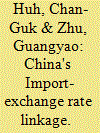

|
|
|
|
|
| Publication |
2014.
|
| Summary/Abstract |
This paper examines how the China-bound exports of Japan and Korea are related to exchange rates, motivated by the fact that processing trade makes up a large proportion of China's trade, and that Japan and Korea are the leading source countries for processing imports. Because processing imports are inputs for exports, the link between such imports and China's exchange rates are ambiguous. We estimate export functions that include China's RMB real effective exchange rates (REER) along with bilateral real exchange rates (BRER) using Johansen's cointegration method and find that the RMB REER significantly affects Japanese and Korean exports to China, even more so than BRER in most cases examined. These two exchange rates appear in the export equations with opposite signs. Subsequently, we use the estimated model to illustrate the importance of accounting for a concurrent change in BRER when analyzing the effects of a hypothetical RMB revaluation on China's trade balances despite the apparently weak imports-BRER linkage.
|
|
|
|
|
|
|
|
|
|
|
|
|
|
|
|
| 4 |
ID:
121806
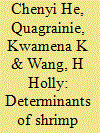

|
|
|
|
|
| Publication |
2013.
|
| Summary/Abstract |
Shrimp farmers in the USA are facing the situation of increased imports resulting in reduced market share, falling prices, and reduced profitability for their farm-raised shrimp. The study examined the determinants of shrimp imports from China, Vietnam, Thailand, and Indonesia using an augmented gravity model of international trade. The results reveal that US imports from the four exporting countries are significantly affected by the GDP of exporting countries, GDP of the USA, exchange rate, unit import value (proxy for import price) of shrimp, and tariff. Tariff policy has implications for the US shrimp industry.
|
|
|
|
|
|
|
|
|
|
|
|
|
|
|
|
| 5 |
ID:
113966


|
|
|
|
|
| Publication |
2012.
|
| Summary/Abstract |
The explosive growth in India's mobile telephony during the last decade coincided with a robust growth in its trade with China. A variety of imported equipment from China played a critical role in augmenting the use of mobile phones and expansion of networks in India. This paper studies the trends of these imports and examines the reasons for their penetrating deep into the Indian market. It argues that Chinese imports bridged a serious supply-side deficiency in India's telecom sector: the absence of a modern indigenous equipment manufacturing industry. Pointing out that development of the latter has been stunted due to low R&D, limited innovations, lack of access to finance, and liberal access to imports, the paper argues that Chinese imports are likely to continue until these conditions prevail, notwithstanding security concerns over such imports.
|
|
|
|
|
|
|
|
|
|
|
|
|
|
|
|
| 6 |
ID:
182792
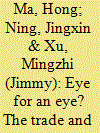

|
|
|
|
|
| Summary/Abstract |
We analyze the trade and price effects of China's retaliatory tariffs on imports from the United States in the period from January 2017 to May 2019. We apply the difference-in-differences approach to the up-to-date China Customs data on imports disaggregated by eight-digit HS product category and source country. We find large reductions in the value and quantity of imports from the US and an almost complete tariff pass-through onto import prices. These results remain robust to extensive changes in the specification and in data sample and to a variety of placebo tests using processing imports or exempted products that were originally included in the tariff lists but removed before implementation. We also find that the trade and price effects are heterogeneous across products, differing either in the end-use or in the ownership types of the importing firm. Similar to recent findings in the US (Amiti et al., 2019, Amiti et al., 2020), our estimates suggest limited terms-of-trade gain due to China's tariff hikes.
|
|
|
|
|
|
|
|
|
|
|
|
|
|
|
|
| 7 |
ID:
130867
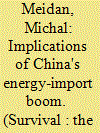

|
|
|
|
|
| Publication |
2014.
|
| Summary/Abstract |
Ensuring access to foreign oil has lost its dominance in Beijing's energy-policy debates. Ensuring access to ever larger quantities of foreign oil has been a focus of debate in China since the late 1990s, when the country's growing oil-import dependence became an inescapable reality. Research institutes and advisers to the Chinese leadership had been preoccupied with identifying the risks associated with China's foreign-oil supplies and devising policies to mitigate them. Yet, as the debate unfolded, it became clear that securing oil supplies was only part of the problem. The overall balance of energy supply and demand, the impact of state-controlled pricing and administrative intervention on the domestic market, and the weakness of institutions governing the energy industry came to be seen as problems that were equally, if not more, pressing. Between 2000 and 2004, a series of events highlighted various aspects of China's energy insecurity and, combined with a change of leadership in Beijing, ultimately led to a shift in energy-policy choices.
|
|
|
|
|
|
|
|
|
|
|
|
|
|
|
|
| 8 |
ID:
087652
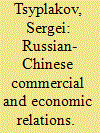

|
|
|
|
|
| Publication |
2009.
|
| Summary/Abstract |
The history of economic relations between the Russian Federation and China breaks down into two periods differing in scale, evolution speed, content of economic exchanges, and mechanisms and their driving forces behind them. The first period began in 1992, that is, at the time when Russia and China entered into direct trade and economic relations, and ends with the close of the 20th century. The second period is running just now.
The first period was highlighted by two opposing trends. In particular, the 1990s were dominated, in political terms, by the development of "Russian-Chinese relations of equal and confidential partnership to achieve strategic cooperation in the 21st century," which laid a constructive groundwork for establishing commercial and economic links
|
|
|
|
|
|
|
|
|
|
|
|
|
|
|
|
| 9 |
ID:
189308


|
|
|
|
|
| Summary/Abstract |
This article presents a comparative macroeconomic analysis of the results of agricultural policy in the area of food security in Russia. China, and Japan. Russia has a lot more agricultural land - a factor of basic importance in food production - than its eastern neighbors China and Japan. China is the leader in terms of gross agricultural production, especially in cereal crops and grain legumes, stone fruits, berries, citrus fruits and grapes, vegetables, melons and gourds, as well as eggs. With respect to those products, China has complete self-sufficiency, but at the same time, the country experiences shortages in its own production of potatoes, meat, and milk. Japan cannot fully supply its own stone fruits, berries, citrus fruits and grapes, vegetables, melons and gourds, as well as meat and milk. Russia also has a shortage in its production of those products, with the exception of meat, of which it has ample supply. The average Russian citizen does not consume enough vegetables, melons and gourds, as well as milk and dairy products, for which there is a low level of self-sufficiency and economic accessibility in the country.
|
|
|
|
|
|
|
|
|
|
|
|
|
|
|
|
| 10 |
ID:
167820
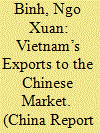

|
|
|
|
|
| Summary/Abstract |
From the characteristics of the Chinese market and the current status of Vietnam’s exports to this market, this article tries to point out the risks that Vietnamese exporters have to identify in order to find ways to overcome those risks, thereby to help increase exports from Vietnam to the Chinese market which is a very important market of Vietnam. In this article, the author does not focus on the opportunities brought about by the Chinese market or the current status of Vietnamese exports of goods to this market. The aim of the article is mainly to identify the risks that come from the Chinese customers or Chinese trade policy, etc. The intention of the author is to evaluate the risks and current policy practices in order to bring about recommendations for policymakers to deal with the risk involved in current Vietnam–China trade. To achieve the above objectives, the article uses analytical, statistical and comparative methods. These are common methods in economic and business analysis. Research data are collected from primary and secondary sources, that is, the data collected from domestic and international authors, from the general department of statistics, general department of customs and Ministry of Industry and Trade of Vietnam. The article argues that the Chinese market is very important for exports from Vietnam and contains many risks; and that it is imperative to identify these risks. It also considers what the government and enterprises of Vietnam have to do to overcome these risks.
|
|
|
|
|
|
|
|
|
|
|
|
|
|
|
|
|
|
|
|
|